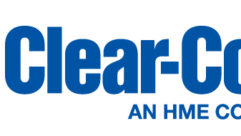

The CR-94M digital extender from RT Com USA offers speed in switching and scaling unlike any other. A nine-input and four-output hybrid matrix router commonly referred to as a presentation switcher, the CR-94M has seven digital video inputs and two analog video inputs. Digital inputs are broken down into four HDMI/DVI inputs and three remote inputs that accept either a Cat or fiber connection from a transmitter. Two analog inputs can be configured as VGA, component, S-Video, or composite. Four video outputs are present, and the switcher is available in two configurations. One configuration offers four HDMI/DVI outputs and another has two HDMI/DVI outputs with two Cat-style outputs that allow a remote display connected with a Cat receiver. In addition, Cat and fiber inputs can be selectable, and VGA/YPbPr/composite/S-Video inputs can be selectable.
In essence, a CR-94M/CR-94M-C can be expanded up to 16 inputs, if desired, as long as certain inputs are not used simultaneously. The unit is 3RU. It features discrete scaling to each output, audio embedding to each digital video source, and the ability to use fiber and Cat-6 inputs from distant sources without additional baluns. A discrete audio output is supplied in analog, coax, and optical digital formats to use when connecting to an audio processor located in the same rack without the need for a separate audio de-embedder. Control is done through both RS-232 and IP—all digital inputs are HDCP-compliant.
The version I tested was a CR-94M that uses four direct outputs. I hope to test a CR-94M-C version with two Cat outputs at another time. I had one UWI two-gang wallplate with a Cat output connected to one of the Cat inputs on the CR-94M. The UWI has a DVI input that will accept HDMI with HDCP using an adapter and VGA with audio. It is rated for a distance of up to 150ft. Front-panel connections include an HD-15 connector, an HDMI connector, and a 3.5mm stereo mini plug.
The rear surface hosts a Phoenix-style serial connection point for control of a local RS-232 device, an RJ-45 jack, and a Phoenix connector, which accepts power from an included power supply. An input-select button allows front-panel or remote RS-232 switching. UWI is specifically designed for system integration and fits comfortably in a standard two-gang electrical box, but it is also self-contained and can be mounted directly in furniture or to any other surface without additional hardware. The UWI has a rotary dial for setting the EDID timing, which includes an automatic mode plus manual overrides for many common resolutions.
In order to test various types of inputs, I used an HDMI test generator, digital media player, portable camera, and a laptop. The media player and camera had simultaneous HDMI and composite outputs. The camera outputs were available one at a time. The laptop had separate HDMI and VGA outputs. By using multiple outputs from several sources, I was able to test each input on the CR-94M along with testing both inputs on the UWI. For displays, I used an NEC 46in. LCD 1280×1024 computer monitor with HDMI, 19in. 720p LCD consumer TV, and an Atlona DIS7-PROHD 1080p test monitor. Since this product is a switcher/scaler, I wanted to test the operation when sending signals to displays with varying resolutions. Each output was connected with an HDMI cable directly to a display from the output of the switcher using cables less than 20ft. All inputs were connected with a 6ft. HDMI cable and the Cat cable for UWI was 10ft. Initial configuration was done through the onscreen menu system on the front of the unit. The menu was extremely intuitive. I was able to successfully set up each input to accept the correct type of connection without any assistance from reading the user manual. Configuration of the network was done from the front panel, as well. Once an IP address was set, a web browser was used to further configure details such as output resolution for internal scalers and sources selected for each output.
Switching could be done using several methods. The unit’s front panel provides manual switching and there’s also a web interface for users to switch inputs. Rarely will the units front-panel operation be used in a typical conference room. It is also doubtful that in an integrated room a web interface would be used as the primary switching interface. True ease of use comes from using the RS-232 or IP control from a standard control system. For testing purposes, I have a Crestron PRO2 to use along with a Crestron XPanel that was quickly built. The protocol manual was easy to read and straightforward, even if the protocol itself was more complex than typically found on most switchers. I decided to use IP for testing, since it was advertised in the specifications as having IP control. The protocol document mentioned nothing about IP control; however a quick phone call to their tech support answered my question. I learned that the commands for IP are the same as RS-232, and they told me the TCP port used for control is the standard telnet port 23. The time required to build an XPanel and write the program from scratch to switch each of the four outputs to any of the nine inputs took around 10 minutes. Using the XPanel program, I was able to effortlessly switch between sources on each of the destinations. I was astounded at the speed at which the switching occurred. I have been in the AV industry for more than 20 years, and I can say that I’ve never seen a digital switcher that responds and switches as quickly as this one. I felt like the switcher had Spider-Man’s Spider-Sense and could predict what button I was about to press. The instant I pressed the button to switch to another source, the display instantly changed and the source was locked in before release of the button. I don’t know how to accurately describe how fast it was outside of doing stop-motion photography showing the mouse click on the web panel and the display showing the source.
The API has many changeable parameters such as output timing, HDMI audio output breakaway, stereo audio output breakaway, preset recall, RS-232 baud rate assignment, LAN address assignment. Most of these parameters are items that would be configured once in the web interface and never changed, but it is helpful to have these available through a remote control interface. The scaling worked well and I did not notice any viewable artifacts on any of the displays. Using the web interface changed the output resolution and results were immediately visible. The UWI module provided a remote input that was connected to a Cat-5 cable. I couldn’t notice a difference in the signal quality when comparing the input using the UWI to one that was connected directly to an HDMI input. One drawback when using the UWI is that it requires a separate power supply. It would be better if the power were provided over the Cat-5 cable so a single cable from the main rack could be used to connect the UWI. The UWI has a VGA connector, a DVI connector, and a 1/8in. stereo audio connector. When using HDMI, you will need an adapter to connect the HDMI cable to the DVI input, but audio will pass through the HDMI cable even though it is connected to a DVI input. When either DVI or VGA is connected, it will automatically switch to the source that is connected. When both are connected, the DVI input has priority. The audio connector can be used to send audio when a VGA signal is connected or when a DVI signal is present. When using the DVI input for HDMI signals, audio input is not used because HDMI has audio included as part of the signal. A particular quirk that I observed was the lack of the ability to send standalone audio without having a video source connected. I tested with a VGA signal from a computer while having the audio input connected from an MP3 player. As long as the VGA signal was present, the audio from the MP3 player was passed through to the display. When the VGA was disconnected, the audio continued to play for around 5 seconds before it was turned off. I called RT Com to confirm that the audio is only enabled while a video signal is present. This was not unusual and the operation of the audio on the UWI wallplate was similar to other manufacturers with the same style of Cat wallplate extender.
Overall, I was pleasantly surprised by the performance and features available in this unit, considering the price. It is hard to do a direct comparison because most products in this category only have one output. A few have two outputs that are independently selectable; a far smaller number provide four outputs that are each scaled and independently controlled. Of the products that do have four outputs, this one is priced as one of the least expensive with performance and features that most would expect to cost much significantly more. RT Com USA is a viable contender in the switcher/scaler playing field that is filled with many choices.
PRODUCT SUMMARY
Pros: independent scaling on all 4 outputs; external control using RS-232 or TCP/IP
Cons: UWI input plate requires separate power supply, power not over Cat cable, complex control protocol
Applications: Any needing a heavy-duty switcher
Price: $8,950 (CR-94M); $899 (Wall Plate TX UWI)
SPECIFICATIONS
Inputs:
9-channel source input
2 DVI / HDMI input (input 1~4)
· Resolution : PC (~WUXGA), HDTV (~1080P)
· DVI 1.0 / HDMI 1.3, HDCP
· 3.5mm TRS for analog stereo audio
CAT6/CORE OPTICAL INPUT (INPUT 5~7)
· resolution : PC (~WUXGA), HDTV (~1080P)
· HDMI 1.3, HDCP
· Cat-6 (Max 50 meters)
· 2 CORE OPTICAL (MULTI, SINGLE MODE fiber optical cable)
ANALOG INPUT(INPUT 8~9)
· 12-bit 170 MSPS ADC
· VGA to WUXGA and 1080p/60Hz
· Signal format : RGB, YPBPR, CVBS, S-VIDEO
· Supports resolutions: RGB (~WUXGA), YPBPR (~1080P), CVBS / S-VIDEO (NTSC,PAL)
2CH BALANCED AUDIO INPUT
· Stereo audio output or embeded in HDMI output signals
Outputs
· 2CH HDMI/DVI OUTPUT and 2CH CAT-X output
· (4) OPTICAL, COAXIAL digital audio
· STEREO AUDIO (RCA)
Control
· RS-232C 9600~115200Bps
· LAN, TCP/IP TELNET









